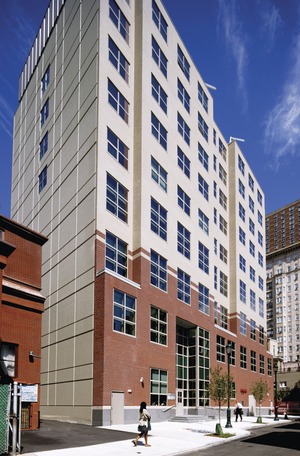

In creating Lenfest Hall for the Curtis Institute of Music, designers and contractors learned to make beautiful music together. Like an orchestra preparing to perform a complicated composition, the endeavor required months of practice, but ultimately the team delivered a $48.5-million facility that hits high notes for design quality, engineering excellence and construction challenge.
During its nearly nine-decade-long history, the conservatory has earned a reputation for training exceptionally gifted young musicians for careers as performing artists at the highest professional level.
But over the years its facilities had become outdated, says Elizabeth Warshawer, executive vice president, chief operating officer and chief advancement officer at the Curtis Institute of Music. The school was badly in need of rehearsal, dormitory and dining spaces.
"With this new building, we had an opportunity to think about the programmatic issues that have existed here for a long time," she says.
Making Space
The first concern was finding adequate space. The team selected a 14,820-sq-ft parcel on Locust Street that included two 19th-century town homes that bookended a modern building. The team retained the historic facades and demolished the remaining structures.
A new four-story facade at street level features a design that provides continuity with the townhouses. An additional five floors that house the student residences are set back from the street elevation so that they are not immediately visible from the street.
The new building houses student and guest dining rooms, a kitchen and a student lounge on the ground level. The second floor has teaching studios and a rehearsal hall. The third and fourth floors contain additional teaching space, and the fifth floor houses public space, an outdoor terrace and student residences. The sixth through ninth floors are exclusively residential.
Although the building houses multiple functions, the demands of a performing arts facility can be seen throughout. Acoustic properties were taken into consideration in nearly every aspect of the building.
Industry-standard levels of quality did not apply, says Brett Endy, senior project manager at INTECH. The acoustics design firm Kirkegaard Associates, Chicago, collaborated closely with all engineers and contractors to ensure that the highest quality sound isolation and soundproofing was achieved. Work required constant monitoring to ensure it was installed in compliance with the design documents and the acoustic consultant's stringent specifications.
"Early on, we'd look at the detailing and it didn't seem right," Endy adds. "There was a learning process [for us] to understand the acoustician's intent. Everyone was learning the science behind it."
The rehearsal space was planned to be performance quality, and all practice rooms required acoustic isolation. Even residential rooms had acoustic requirements that would enable students to practice in their rooms without disturbing their neighbors. Many strategies were implemented, including box-in-box construction, floating floors, sound lock doors, isolation of equipment and, most importantly, the proper sealing of every penetration into a space.
"In regard to acoustics, we had a series of protocols for design moves," says Dan McCoubrey, principal at Venturi, Scott Brown and Associates, Philadelphia. "For example, ductwork couldn't connect from one room to the next; it all had to go into the corridors. You also couldn't bundle conduit; each had to have its own hole with a specific distance in between. That drove a lot of the engineering."
Meanwhile, the architectural vision had to remain intact. The historic facades were cleaned, repaired and restored. New windows with historic profiles replaced any missing original windows. Existing windows were restored with matching detailing. The crew recreated an ornamental stone arch window, original to one of the historic facades, that had been removed and replaced with a storefront several decades ago. The restoration employed stone chiseling by hand to match the intricate detailing of the original opening.
High-quality finishes were required throughout. From the cherry wainscoting to the soundproof windows, from the hardwood floors to the carefully constructed ceiling in the rehearsal hall, everything was carefully designed and executed.
"We drilled into our subcontractors early on that if they thought this would be a run-of-the-mill dormitory, they wouldn't do well on this project," Endy says. "We stayed on our guys constantly to push the importance of quality and the need to understand details of the drawings."
Warshawer says the new building is a source of pride for the school, a space worthy of the world-class conductors who visit the conservatory. Moreover, it established a new sense of community.
"The building not only met our expectations, it exceeded them," she says. "For the first time, we truly have a space where everyone can convene and bring the whole community together. That's something we didn't anticipate, but we cherish it."
Curtis Institute of Music - Lenfest Hall, Philadelphia
Key Players
General Contractor: INTECH Construction, Philadelphia
Owner: Curtis Institute of Music, Philadelphia
Lead Design: Venturi, Scott Brown and Associates, Philadelphia
Structural Engineer: Keast & Hood Co., Philadelphia
MEP: Marvin Waxman Consulting Engineers, Philadelphia
Acoustical Engineer: Kirkegaard Associates, Chicago and Boulder
Audio-Visual Consulting: Metropolitan Acoustics, Philadelphia
Submitted by: INTECH Construction


Post a comment to this article
Report Abusive Comment